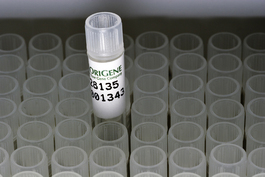GFAP (NM_001242376) Human Untagged Clone
CAT#: SC331793
GFAP (untagged) - Homo sapiens glial fibrillary acidic protein (GFAP), transcript variant 3
"NM_001242376" in other vectors (2)
Product Images

Other products for "GFAP"
Specifications
| Product Data | |
| Type | Human Untagged Clone |
| Tag | Tag Free |
| Symbol | GFAP |
| Synonyms | ALXDRD |
| Vector | pCMV6 series |
| Sequence Data |
>NCBI ORF sequence for NM_001242376, the custom clone sequence may differ by one or more nucleotides
ATGGAGAGGAGACGCATCACCTCCGCTGCTCGCCGCTCCTACGTCTCCTCAGGGGAGATGATGGTGGGGG GCCTGGCTCCTGGCCGCCGTCTGGGTCCTGGCACCCGCCTCTCCCTGGCTCGAATGCCCCCTCCACTCCC GACCCGGGTGGATTTCTCCCTGGCTGGGGCACTCAATGCTGGCTTCAAGGAGACCCGGGCCAGTGAGCGG GCAGAGATGATGGAGCTCAATGACCGCTTTGCCAGCTACATCGAGAAGGTTCGCTTCCTGGAACAGCAAA ACAAGGCGCTGGCTGCTGAGCTGAACCAGCTGCGGGCCAAGGAGCCCACCAAGCTGGCAGACGTCTACCA GGCTGAGCTGCGAGAGCTGCGGCTGCGGCTCGATCAACTCACCGCCAACAGCGCCCGGCTGGAGGTTGAG AGGGACAATCTGGCACAGGACCTGGCCACTGTGAGGCAGAAGCTCCAGGATGAAACCAACCTGAGGCTGG AAGCCGAGAACAACCTGGCTGCCTATAGACAGGAAGCAGATGAAGCCACCCTGGCCCGTCTGGATCTGGA GAGGAAGATTGAGTCGCTGGAGGAGGAGATCCGGTTCTTGAGGAAGATCCACGAGGAGGAGGTTCGGGAA CTCCAGGAGCAGCTGGCCCGACAGCAGGTCCATGTGGAGCTTGACGTGGCCAAGCCAGACCTCACCGCAG CCCTGAAAGAGATCCGCACGCAGTATGAGGCAATGGCGTCCAGCAACATGCATGAAGCCGAAGAGTGGTA CCGCTCCAAGTTTGCAGACCTGACAGACGCTGCTGCCCGCAACGCGGAGCTGCTCCGCCAGGCCAAGCAC GAAGCCAACGACTACCGGCGCCAGTTGCAGTCCTTGACCTGCGACCTGGAGTCTCTGCGCGGCACGAACG AGTCCCTGGAGAGGCAGATGCGCGAGCAGGAGGAGCGGCACGTGCGGGAGGCGGCCAGTTATCAGGAGGC GCTGGCGCGGCTGGAGGAAGAGGGGCAGAGCCTCAAGGACGAGATGGCCCGCCACTTGCAGGAGTACCAG GACCTGCTCAATGTCAAGCTGGCCCTGGACATCGAGATCGCCACCTACAGGAAGCTGCTAGAGGGCGAGG AGAACCGGATCACCATTCCCGTGCAGACCTTCTCCAACCTGCAGATTCGAGGTCAGTACAGCAGGGCCTC GTGGGAAGGGCACTGGAGTCCTGCCCCCTCCTCCAGGGCCTGTAGGTTGCTCCAGACTGGGACTGAGGAT CAGGGCAAAGGGATCCAGCTCTCCCTGGGGGCCTTCGTGACACTGCAGCGCTCCTAG |
| Restriction Sites | SgfI-MluI |
| ACCN | NM_001242376 |
| OTI Disclaimer | Due to the inherent nature of this plasmid, standard methods to replicate additional amounts of DNA in E. coli are highly likely to result in mutations and/or rearrangements. Therefore, OriGene does not guarantee the capability to replicate this plasmid DNA. Additional amounts of DNA can be purchased from OriGene with batch-specific, full-sequence verification at a reduced cost. Please contact our customer care team at custsupport@origene.com or by calling 301.340.3188 option 3 for pricing and delivery. The molecular sequence of this clone aligns with the gene accession number as a point of reference only. However, individual transcript sequences of the same gene can differ through naturally occurring variations (e.g. polymorphisms), each with its own valid existence. This clone is substantially in agreement with the reference, but a complete review of all prevailing variants is recommended prior to use. More info |
| Product Components | The cDNA clone is shipped in a 2-D bar-coded Matrix tube as dried plasmid DNA. The package also includes 100 pmols of both the corresponding 5' and 3' vector primers in separate vials. Every lot of primer is tested to provide clean sequencing of OriGene TrueClones. |
| Reconstitution | 1. Centrifuge at 5,000xg for 5min. 2. Carefully open the tube and add 100ul of sterile water to dissolve the DNA. 3. Close the tube and incubate for 10 minutes at room temperature. 4. Briefly vortex the tube and then do a quick spin (less than 5000xg) to concentrate the liquid at the bottom. 5. Store the suspended plasmid at -20°C. The DNA is stable for at least one year from date of shipping when stored at -20°C. |
| Reference Data | |
| RefSeq | NM_001242376.1, NP_001229305.1 |
| RefSeq Size | 2193 bp |
| RefSeq ORF | 1317 bp |
| Locus ID | 2670 |
| Cytogenetics | 17q21.31 |
| Protein Families | ES Cell Differentiation/IPS |
| Gene Summary | 'This gene encodes one of the major intermediate filament proteins of mature astrocytes. It is used as a marker to distinguish astrocytes from other glial cells during development. Mutations in this gene cause Alexander disease, a rare disorder of astrocytes in the central nervous system. Alternative splicing results in multiple transcript variants encoding distinct isoforms. [provided by RefSeq, Oct 2008]' Transcript Variant: This variant (3) differs at the 3' coding region and 3' UTR, compared to variant 1, which results in a protein (isoform 3, also known as isoform kappa) with a shorter and distinct C-terminus when compared to isoform 1. |
Documents
| Product Manuals |
| FAQs |
Resources
{0} Product Review(s)
0 Product Review(s)
Submit review
Be the first one to submit a review
Product Citations
*Delivery time may vary from web posted schedule. Occasional delays may occur due to unforeseen
complexities in the preparation of your product. International customers may expect an additional 1-2 weeks
in shipping.






























































































































































































































































 Germany
Germany
 Japan
Japan
 United Kingdom
United Kingdom
 China
China

